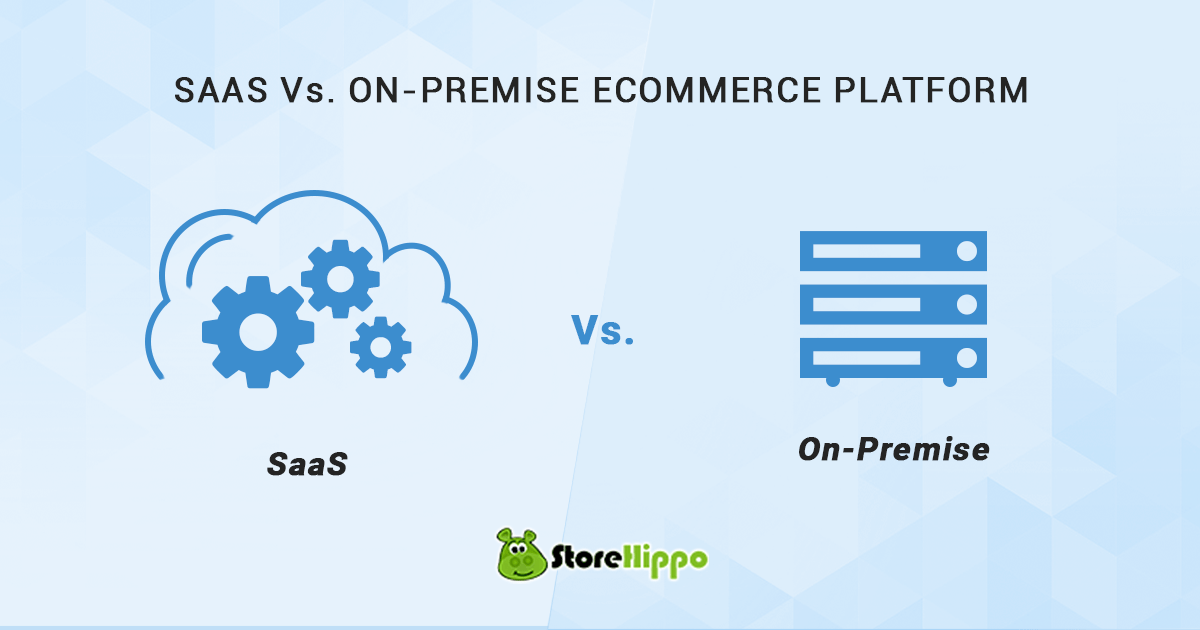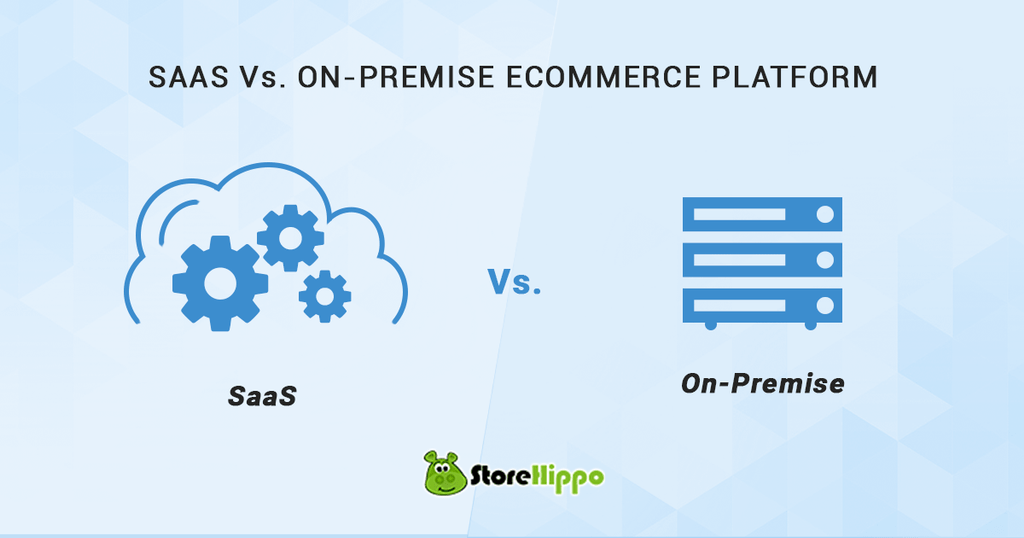Whether you are starting your new online business or planning to give a new sales channel to your enterprise business by building your online presence, you need a feature rich and robust ecommerce platform to do so.
However, to ensure that your business does well stays ahead of the competition you must make an informed decision about the base that powers your business. If you make a wrong decision you not only run the risk of damaging your brand reputation but you might also incur heavy costs in the first set up and eventual migration to a better solution.
Things can get messier if you are considering an enterprise ecommerce platform and it fails to fit your requirements. While there are numerous solutions in the market, deciding on the right one for your business needs some careful evaluation.
Table of Contents
SaaS Vs On-Premise: Which is the best fit for you?
While there are many solution providers for ecommerce in the market, they basically fall into two broad groups, i.e,
- On-Premise Solutions like Magento, WooCommerce etc.
- SaaS Ecommerce Platforms like StoreHippo, Shopify etc.
Before we dig further, let's try to understand both these models and their basic set up. Also, going further we will explain what makes one more popular and better fit for SMEs or enterprise businesses.
Understanding On-Premise Ecommerce Software
On-premise software is one which is installed locally on the computers and servers of your business. This setup gives complete control to the business owner. He pays for all the equipment and hardware that run his website and can access them physically.
This is the traditional way of deploying any software. Conventionally it was considered the only way to roll out an enterprise business. However, in recent years things have been changing and cloud-based services have gained more popularity.
How SaaS Ecommerce Platform Is Different From On-Premise Software
As it is clear from the very name SaaS(Software As A Service) ecommerce solution bundles up a complete set of software, hosting, support and backups to offer a comprehensive service that is ready to use.
This means that the business owner just has to opt for the service and need not have any physical setup to install software or get a web hosting service. All that a business owner needs is a computer and internet connectivity. He can roll out his online store by opening his store-account on a SaaS-based ecommerce platform.
Why SaaS Ecommerce Solution Is Gaining Popularity
The global Ecommerce boom in the last decade has given a huge opportunity for every entrepreneur who has an idea to monetize. The markets have opened up beyond geographical boundaries and with SaaS ecommerce platform it has become super easy to start a business within days.
SaaS solutions have taken away the pains of development and offered a hassle-free and cost-effective way of going online for businesses of every scale and size.
The factors that have contributed to its massive growth and widespread use are:
Growing Internet and Mobile Penetration
The global internet and mobile penetration has increased substantially since 2014. In 2014, 48.8% of the global mobile phone users accessed the internet from their mobile phone. This is expected to reach 63.4% in 2019. (Source: Statista )
Business On The Go
The savvy business owners of today have a life on the go and SaaS makes it easier to run a business right from your mobile. With a SaaS Ecommerce platform, one can connect from anywhere not just the physical office.
User Affinity For Web-Like Interfaces
Web-like interfaces have become very popular and users like them better than on-premise solutions. The ease of use and simplicity of web-like environments have made SaaS Ecommerce platform the first choice of online businesses.
Mature Digital Technologies
In due course of time, digital technologies have been standardised and thus have a common protocol. This has made it easier to offer improved user experience by integrating and scaling cloud-based services and programs.
Flexible Solutions
SaaS Ecommerce platforms offer greater flexibility both to the business owner and the customers. With SaaS, it is easier to add new modules or tweak the existing ones. Also, scaling up to new users or markets is much easier and hassle-free.
How SaaS Ecommerce Platform Gives An Edge To Your Business
Starting an online business seems like a Herculean task if you are still opting for the on-premise approach. Whether you start the development in-house or outsource it to an experienced development company, it will still take considerable time and resources to be up, running and tested and fixed thoroughly.
This is where SaaS solutions have a significant advantage as they allow you to go online without worrying about the development, hosting or any other technicalities. Let us see how SaaS Ecommerce Platform is so popular and why it is growing rapidly:
1. Business Agility
SaaS gives agility to your business. As the solution has already been deployed and tested in real-time for a variety of businesses you are sure about what you are getting. SaaS solutions are known to give customer centric UI/UX experiences that enhance engagement and conversions. Also, with different subscription models, you can easily switch to a more complex feature set without spending time on development and deployment.
SaaS Ecommerce platform thus saves a lot of hassle and allows business owners to focus on business growth rather than spending time on core development.
2. Lower Costs
Going with on-premise systems means investing upfront to buy licensed software as well as hardware. Also, you need to invest in a technical team to assemble these and make them functional. Also, despite the ideal conditions, the complete system will need maintenance periodically which will be another cost overhead.
SaaS ecommerce platforms are relatively inexpensive and also do not require a technical team to assemble or maintain the system. You get all the technical support from your solution providers. Research suggests that over a period of 4-5 years SaaS solutions can be almost 50% less costly than an on-premise solution.
3. Designed For Ecommerce
SaaS solutions for Ecommerce have been built with ecommerce as the focus. This means they have inbuilt capabilities to cater to the diverse requirements of Ecommerce. Their servers are optimized to handle peak load seasons without the need to increase the server size. This ultimately translates to better and faster site performance which keeps your customers loyal to your business.
On the other hand, if you develop an on-premise software, you will have to consider the peak load and accordingly decide the server configuration. This means that you will be paying year round for peak load and the full potential will remain unutilized. Unlike SaaS Ecommerce platform, on-premise software has to be designed from scratch to accommodate various nuances of ecommerce business. This means you need to go through iterative development cycles to find the right solution for your requirements.
4. Made For Mobile
Modern Ecommerce is all about mobile commerce. Depending on the industry from 50% to 80% of online sales are coming through the mobile channel. This means your website should be designed for mobile so that you can target and convert visitors from the mobile channel.
5. Ease of Use
SaaS Ecommerce platforms are definitely much easier to use as it offers a turnkey solution that is ready to use. It frees an entrepreneur from the worries of software purchase and installation, hosting and maintenance of servers and other devices used for your business setup.
Alternatively using an on-premise solution means you will have to set up things from scratch and also spend considerable time in choosing the various third party providers to complete your setup. This definitely is a tough task and distracts you from focusing on business growth.
6. Reduces Go to Market Time
One of the biggest advantages of turnkey SaaS solutions for ecommerce is that they substantially reduce the go to market time. With the pre-built solution for various business models, all business needs are to pay for the subscription and set-up the online store within days.
This benefit has also made it popular as an enterprise ecommerce platform where it makes it faster for large volume businesses to deploy a solution and start selling the products or services in no time.
7. Enhanced Security
The onus of building secure sites that conform to all the security standards lies with your SaaS software solution provider. Since they are already handling thousands of sites they adhere to industry best practices and offer PCI DSS compliant payment channels, SSL enabled websites and also take care of cybersecurity norms. This ensures the security of your business and client data thus building a loyal client base.
If you opt for on-premise solutions instead of SaaS ecommerce platform securing your data and servers will be your responsibility. This is a time and resource consuming task and also distracts you from focusing on your business.
8. Extensive Features
SaaS ecommerce software is built to provide a comprehensive end-to-end business solution for all your selling needs. This means that it has an extensive set of features that not only let you sell products but also takes care of your marketing, social media presence, supply chain and everyday business management. Also, there are more complex features that help the larger business to go online using the SaaS-based enterprise ecommerce platform.
To get the same features and tools with an on-premise ecommerce solution you will have to hire a technical team that can code and implement all the features and flows required for your business.
9. Extensibility
SaaS solutions for ecommerce are designed to offer great extensibility. You can easily use various apps and third-party extensions to enhance the functionality of your existing setup. For example, you can integrate mailing software, ticketing software, tracking software, notification channels like SMS and PUSH etc. to enhance your communications and marketing.
Setting up all these for using an on-premise solution will require considerable coding effort. If you happen to use these on your enterprise ecommerce platform the resource and time needed might go up substantially given the complexity of the business model.
10. Customizations
Usually, it is believed that it is easier to do customizations for enterprise and large scale businesses if you are using on-premise software. However, this does not hold true when you are considering an open-source platform that does not have a standardised and uniform code. With such a setup if you have to customize your enterprise ecommerce platform you would need someone who understands the platform inside out. This means costly development and slow implementation.
On the other hand, the good SaaS solutions like StoreHippo are simplified and made on the DIY(Do-It-Yourself) concept. This makes the whole platform intuitive and enables the users to tweak the frontend as well as the backend. Thus customizations become super easy and also fast to implement. This comes in handy when you are using the SaaS solution to power your enterprise ecommerce platform with its unique flow and marketing requirements. Such ease of customization helps you in creating new flows from existing entities and also allows to create new marketing pages rapidly.
11. No Expenditure On Upgrades
The on-premise model requires a business to buy or lease various software. Even the most awesome software goes through a major upgrade after 3-5 years along with multiple minor upgrades or patches. This means that you have to constantly keep upgrading your ecommerce solution. This involves updating the code, testing it again and fine-tuning.
Isn’t it a lot of work? And what if you have an enterprise ecommerce platform? A small error can create bugs that might break your flow or slow your processes. A SaaS software does away with all these issues as your solution provider takes care of all the upgrades and change in flows. You simply don’t need to bother about these or spend extra to buy a new software. Also, SaaS solutions compete with each other on a host of features so the users always benefit from updates and new additions to the features.
12. ZERO License Fees
This one is a no brainer. With the on-premise solution, you need to pay for various license fees, server, hosting etc. Also, you have to spend money to buy the new upgraded versions. This is a recurring investment.
Alternatively, with a SaaS Ecommerce platform, you just pay for your monthly or annual subscription. Rest all is taken care of by your solution provider. Doesn’t that make life a lot more simple?
13. Support That Covers You
While on-premise solutions do offer some sort of technical support but once you purchase the license the journey thereon is largely unassisted. You can find community support but if you are stuck with any flow or issue you will have to research and look through the forums to find answers. Basically, the kind of real-time assistance and hand-holding one needs for ecommerce disaster management scenarios is largely unavailable.
With a SaaS, ecommerce platform support is an inherent part of your package. You not only get pre-sales but also post sales support where you get a support manager to take care of your store setup. Also, most SaaS solutions provide multi-channel support through email, chat and call support along with detailed help centre documenting the features of the platform.
14. Global Expansions
Saas Ecommerce platform facilitates faster and less complex global expansions. Although going global is the long term goal of most of the businesses, incorporating the idea in your business plan right from the start helps you. This allows you to channelize your efforts to reach the milestones faster.
To go global faster you need a solution that has already considered this option and incorporated it in its plans. This is done by SaaS providers when they add features that turn a simple ecommerce solution into an enterprise ecommerce platform by adding features like support for B2B, multi-vendor marketplace, multi-store setup, multilingual and multi-currency websites etc. These features and tools that are needed for a global market and diverse audience groups.
With an on-premise solution, you cannot have all these features incorporated in your code right from the start. You will instead move one step at a time. Also, you will need to change your server and other software configuration to accommodate all these changes. This makes the process longer and more resource and cost intensive.
Conclusion
Now that we have evaluated the two most popular models, i.e; SaaS Vs On-Premise, it is evident that SaaS Ecommerce platforms are designed for the futuristic ecommerce stores. The rich feature set, low upfront and ownership costs and the quick go-to-market time have made these platforms popular among SMEs as well as Enterprise businesses.
However, not all SaaS solutions are equipped to handle high volume enterprise businesses and you need to be careful about the features that you are getting. StoreHippo has taken care of this gap and offers a full spectrum of features and tools needed for an enterprise ecommerce platform.
Ready to start your next generation online store? Explore the future-ready features of StoreHippo SaaS-based enterprise ecommerce platform. Start your 14-day free trial and explore the features that help you grow and reach new markets.





















Leave a Reply